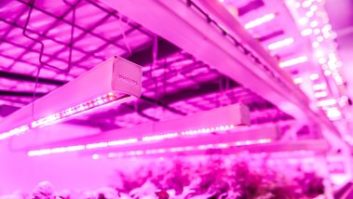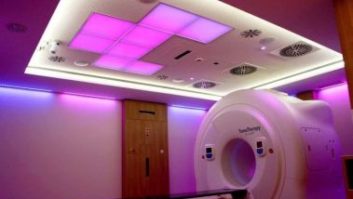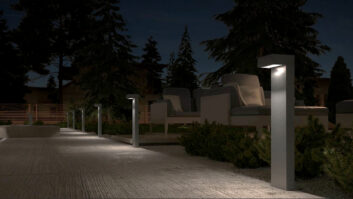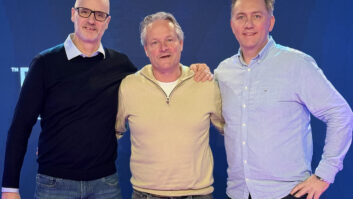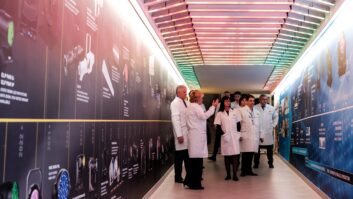Luminous ceiling from Philips simulates daylight to comfort critically ill patients in intensive care while Osram’s new LED lamp offers better light in the operating room.
We all feel better when the sun is shining and the health effects of Vitamin D from sunlight are well known. Can artificial light also have health benefits? Philips’ work in healing environments suggests that it can and the company has now developed an LED-based and media-enabled luminous ceiling that simulates dynamic daylight and plays comforting visual content.
The luminous ceiling is part of an innovative concept developed by the Charité Clinic in Berlin in collaboration with GRAFT architects to research the effects of a controllable atmosphere in hospital rooms on the health of patients.
The LED-based ceiling has been introduced into clinical use by the Charité Campus Virchow Clinic in Berlin as part of a stress-reducing concept called ‘Parametric Spatial Design’. Hospital staff can enter the desired parameters and the large, sky-like area creates visuals and light moods customized to the situation of individual patients, enabled by software from ART+COM. The Clinic has implemented the concept in two of its intensive care patient rooms to enhance the healing environment for patients who are severely ill.@page_break@
Research shows that most people will at least once in their life be treated in an intensive care unit. In many cases, the patients’ lives are at risk as they await an operation or start to recover after surgery. In this critical phase they often find their surroundings irritating and hostile. Clinical research has shown that factors like loud noise, inappropriate lighting conditions and social isolation can increase the risk of patients in intensive care slipping into a shock-like state.
Until now there has been very little data available about the health-related effects of hospital rooms with a controllable atmosphere. For this reason, intensive care physicians, psychologists and sleep researchers at the Charité Clinic in Berlin will continue to work together with its partners GRAFT architects and the ART+COM design studio to use the integrated spatial concept for research over the coming 12 months. The Parametric Spatial Design concept was developed by GRAFT architects, the ART+COM design agency and the Charité Clinic in Berlin in a joint venture and funded by the German Federal Ministry of Economy and Technology (AiF).
Philips has played a significant role in designing this innovative concept, thanks to its expertise in lighting design and technology. “We find that, particularly in such critical areas as the intensive care department, lighting design is becoming increasingly important in the patient environment,” explains Roger Karner, managing director of Philips Lighting DACH. “Together with our partners we can provide healthcare establishments like the Charité Clinic with turnkey lighting solutions that are tailored precisely to the specific needs of their patients,” adds Karner.
LED lighting in the luminous ceiling
The luminous ceiling concept from Philips combines the natural, dynamic rhythm of daylight and the effects of gentle colourful light and visual content. It incorporates 15,400 LEDs and extends from the ceiling onto the wall in front of the patient’s bed, and therefore fills their field of view completely.@page_break@
In addition to the RGB (colour) LEDs, high-performance LEDs with a warm-white and cold-white colour temperature have also been integrated into the ceiling. They are able to produce a light output that is comparable with the light from a clear sky in summer. It is this high level of light output that brings the biological effect of light into the intensive care room. It supports the patient’s natural day/night rhythm and helps to promote healthy sleep patterns.
How the luminous ceiling adapts to patient needs
The first prototype is now in clinical use. In the new intensive care rooms at the Charité Clinic the medical apparatus has been hidden from view and the level of noise has been reduced. The LED luminous ceiling from Philips adapts to suit the patient’s specific wishes: the doctor in charge of the patient’s care enters a number of parameters relating to the patient’s wellbeing on a tablet PC. A program specially designed by ART+COM controls the screen in such a way that the light is tailored to suit the patient’s needs and an appropriate mood is created in the patient room. Amongst other things, live weather updates from the German meteorological office are used to support this process.
Light and its role in enhancing the healing environment
For many years Philips has been researching and developing special lighting systems for hospitals. The advent of digital lighting technology of LED allows an unprecedented level of control of colour temperature and light intensity that has made this new concept possible. Philips has very recently installed its HealWell lighting system in the German Heart Center in Berlin and in other hospitals in Germany, the UK, the Netherlands, Central Europe, Middle East and South East Asia.
This system simulates the natural, dynamic rhythm of daylight. A pilot study carried out in conjunction with the University Clinic in Maastricht has researched the effects of this system: HealWell led to improvements in the quality of sleep of patients, enhanced mood and a rise in satisfaction levels among patients and healthcare workers.@page_break@
Osram Ostar Medical
When it launches the new Osram Ostar Medical, Osram will be introducing the first LED lamp with a high colour-rendering index (CRI) of 95 and the possibility of adjusting the temperature of the colour white. This makes it ideal for medical applications – for instance in operating rooms, where a precisely controlled chromaticity coordinate and high natural colour rendering are crucial.
Osram Ostar Medical comprises four different LED chips in the colours warm white, ultra white, verde and amber. This permits customers to set the shade of white emitted by the LED according to their individual requirements within a colour temperature range of between 3,700 and 5,000 Kelvin – and at a high overall CRI of 95. This combination of precise chromaticity coordinate control and excellent CRI is particularly important for lighting in the medical sector. When optimized for the red spectrum (RaR9), the CRI remains at around 95 so that red shades are particularly true-to-life – ideal for light systems in operating rooms.
With a footprint of just 5.9 mm x 4.8 mm and a housing height of 1.2 mm, the design of the Osram Ostar Medical is very compact. Indeed, it is only about one-quarter as high as the components ordinarily used. The product owes its compact design to the flat, anti-reflex-coated glass cover with which the LED is equipped instead of the usual lens.
“Compact luminaires prevail in the modern medical lighting sector and the low height of the new Ostar Medical makes it the ideal product,” explains Wolfgang Schnabel, who is in charge of marketing the product at Osram Opto Semiconductors. “The component is standardized, which means that customers can use the commonly available lenses.”
